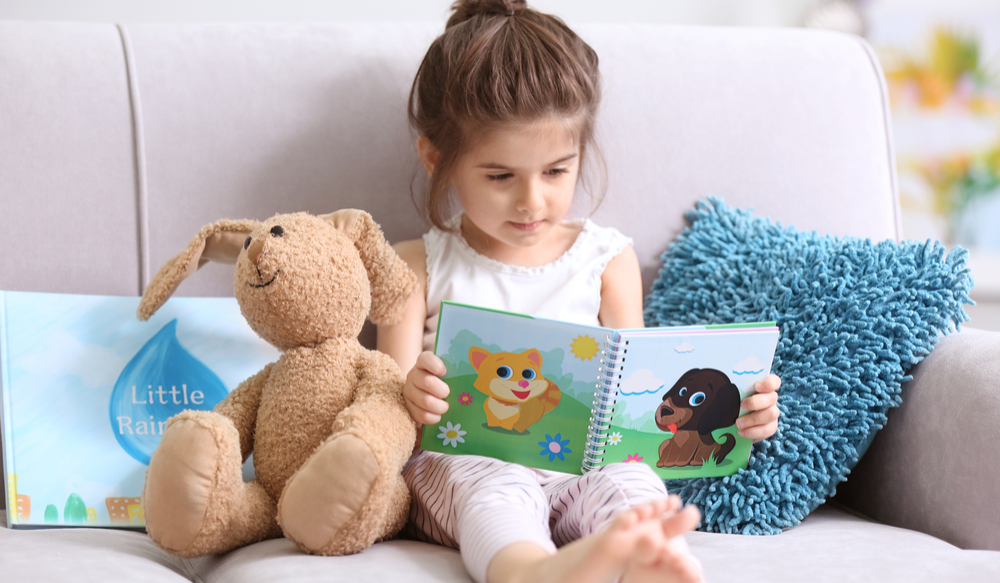By Janis D. Gioia, MAED
“There’s always room for a story that can transport people to another place.”
– J.K. Rowling, novelist, screenwriter and film producer
Stories have the amazing power to comfort anxious children.
Picture books, fairy tales, myths and fables take children on fantastic adventures, to different times and places where they meet extraordinary characters.
They spark children’s curiosity and set their imaginations free.
For all children, and especially those with anxiety, autism, depression, mental health challenges or physical disabilities stories:
-Distract from anxious thoughts
-Ease chronic pain
-Provide role models for empowerment
-Inspire hope and healing.
Sometimes anxious children tell themselves negative stories that play over and over again in their minds.
When that happens, we need to help them turn the page and write a new chapter.
Negative stories cause anxiety, depression, and limit children’s lives.
One year a child in my class struggled to write with a collection of dull, flat-tipped pencils.
I gently asked Sarah why she had not sharpened her pencils.
Through tears she confessed, “Every time I get up to sharpen my pencils, I tell myself that everyone is watching me. I picture myself not being able to work the pencil sharpener. My hands get sweaty and shaky and I’m afraid I will drop the pencils. Then everyone laughs at me. I want to run out of the room and never go back to school.”
That’s definitely not a good story.
Children can always change the stories they tell themselves.
Sometimes the story replaying in their mind is based on something they actually experienced. Other times it is something they project from their imagination.
Regardless of whether it’s fact or fiction, children have the power to rewrite their mental script.
They can tell a story with a better plot and a happy ending.
While most of the current research in narrative psychology focus on adult outcomes, the results are still compelling for children.
In her article “Our Stories, Ourselves” writer Sadie Dingfelder concludes, “Taken together, psychologists’ narrative research makes one resounding point: We don’t just tell stories, stories tell us. They shape our thoughts and memories, and even change how we live our lives.
If stories can change your child’s thoughts, memories and how they live their lives, you need to help them change their negative stories into narratives that are positive and healing.
It sounds simple, and it is.
But it does take time and many repetitions for children to retrain their brains into new and positive channels.
Negative thinking is like a wheelbarrow that has made ruts in the ground.

The more you push it over the same track the deeper the ruts get.
Just as it’s easier to push wheelbarrow in the same deep grooves, your child’s brain finds it easier replay old negative thoughts.
Your job is to help children get their thinking into new and healthy patterns.
“The best way to help a pessimistic (or anxious) child is to teach them how to see the world differently,” explains Cory Cohiolo, CHt, MA of Ajna Hypnotherapy in Chula Vista, California.
“Help them rescript negative thoughts into positive thoughts by retraining the brain.”
(Cory’s YouTube Channel has amazing bedtime stories and meditations just for children.)
Children need to know they can change their story.
“I was seeing a child for depression and anxiety. The root of her anxiety was not being good enough.”
“It went all the way back to when she was four and her father left her mother,” Cory continues. “Leaving them meant to her that she was not a good enough child for him to stay.”
Every time this child’s father visited, and then left, her beliefs were confirmed.
Cory helped her write a new story told from her father’s perspective.
“When she went into her past and watched through her father’s eyes, rather than her own, she saw how hard it was for him. How he loved her. She saw a whole other story which brought out a new truth: She was good enough. She could stop worrying about not doing things right in school.”
“She had a whole new reality,” Cory concludes. “The depression and the anxiety started to become a thing of the past.”
Joanna Gioia, MSSA, LISW-S, Executive Director of Ohio Guidestone Lorain and Erie Counties says, “There’s tremendous personal power in developing the skill of positive re-framing. It shifts one’s ability to seize opportunities where others find challenges, and is a cornerstone element of building up resiliency.”
She continues, “Being able to re-frame one’s experiences can not only manage anxiety, but has the potential to transition it towards a positive energy source.”
6 Ways to Help Children Change Their Stories and Manage Anxiety
Validate
Calmly validate children’s fears…never dismissing them.
This is important. It helps the child connect with the adult and builds trust.
When children’s fears aren’t validated it can lead to mental health stigma and increased anxiety. https://www.comfortinganxiouschildren.com/6-ways-to-help-children-with-mental-health-stigma-with-advice-from-dr-bernice-pescosolido-expert-in-mental-health-stigma/
Educate
Let children know they have the power to change the story. That fact has probably never occurred to them, and it’s very empowering.
Explain that it’s like flicking a light switch in their brain. They have the power to go from darkness into light.
Contemplate
“Find the root cause of the fear,” advises Cory. “Once you find the root cause of the fear, the issues can be put into perspective.”
Sometimes you know the fear, sometimes the child will eagerly share the fear, and other times it might take a bit of detective work.
Restate
Once you know the story, discuss ways to re-tell and re-write the story, leaving out the negatives and focusing on the positive.
If your child doesn’t write, have them dictate it to you.
Add affirmations, wherever you can, to replace worried what-ifs with positive, empowering words.
Here’s an example of a more positive story that Sarah and I developed to help her use the pencil sharpener.
Positive Story: Now that my teacher has helped me practice using the pencil sharpener, I feel confident about sharpening my pencils. When I get up to sharpen them I notice that all the other kids are focused on their work. No one even notices me and the other kids who are by the pencil sharpener. If I drop a pencil, who cares? Everyone does. I can ask my teacher or a friend if I need help. After my pencils are sharpened I walk calmly back to my desk and am prepared to get back to doing the school work that I love.
Create
Little ones might like to draw their story, create it out of Play-Doh or act it out with stuffed animals.
Other artistic outlets for storytelling include making a storyboard or collage (from online photos or magazines), turning their story into a song or poem, or putting on a skit or puppet show.
The more opportunities the child has to explore and rehearse the positive story, the more likely the positive script will replay in their minds when facing their fears.
How have you used stories to help children with fears? Tell us in the comment section below.
Peace, Jan

By signing up, you’ll also receive your free guide with 20 ways to comfort your child…mind, body and spirit.







 in Ohio
in Ohio
11 Comments
This article helped my daughter. She is a teenager, but I find a lot of stuff on your website helps her. I wish you had a website just for teens, but your website is very good.
Hi Mandy’s Mom,
I’m so glad my website helps your daughter. I have had others ask me about a website just for teens. It is something I will pray over, for sure. Peace to you and Mandy, Jan
Hey, Jan, great article about using Positive Stories to help anxious kids. I’m a special education teacher myself and I found this article to be actionable and effective with my third graders, many of whom struggle with anxiety disorders among other things.
Hello John,
I’m so glad you found this article helpful for your students. It seems like we all tend to tell ourselves negative stories, and it’s so helpful when we rewrite them into positive ones. Peace, Jan
Hi John,
I’m so glad this article helped your students. Many of my students struggled with anxiety, too. That’s one reason I started Comforting Anxious Children. Peace, Jan
I have tried your ideas with my son who has asperger’s syndrome and anxiety disorder. He is much more relaxed about going to school and being with other kids. He always told himself nobody liked him. Now we work on telling himself new stories and he is so much more happy and relaxed. It seems like the more relaxed he is with other kids, the better they like him. You have really good articles. I wish you would add a Facebook page for this website. Thanks, Lahdonna.
I’m so glad Comforting Anxious Children helps you help your son. I’m glad he is making friends. Thank you for asking about Facebook. Other readers have asked about a Comforting Anxious Children FB page, too. Maybe one day. Thank you for reading. Peace, Jan
Thank you for this article, Jan. I am a social worker who works with children from trauma backgrounds. I have shared this with my staff. Very good work. Please keep it up.
Hi Stacey,
Thank you for the kind words. I am glad Comforting Anxious Children helps you and your staff. Thank you for all the work you do to help children. Peace, Jan
Dear Jan, Thank you for this article. Your articles are so well done. And I think your website is so peaceful…the way the colors all match. Anyhow, I read all your articles but this one was special. It had so many great ideas to help me help my clients. I am a counselor for children and families on the east coast. I am getting near retirement but always ready to learn something new. Your website has such a nice mix of articles I don’t find anywhere else. I love how your articles are well-researched…they seem like they should be in The Wall Street Journal. Well done, Jan.
Aww, Rose, that was so sweet of you to say. I really appreciate it. I’m glad you enjoy the articles on Comforting Anxious Children. (And I’d love to write for The Wall Street Journal…wish they would ask me to write for them!) 🙂 Peace, Jan